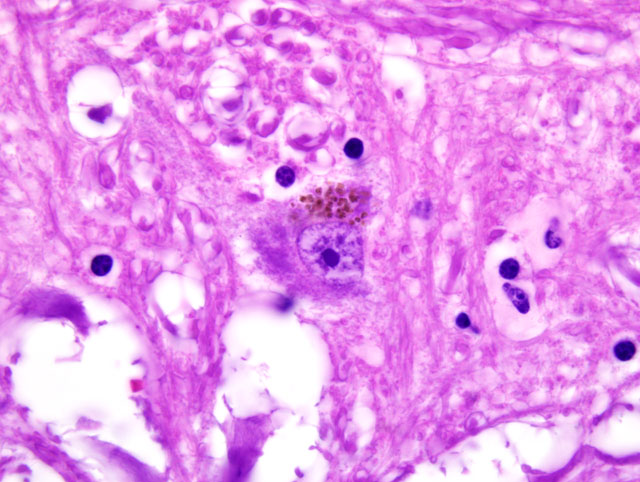Signalment:
Gross Description:
Histopathologic Description:
Morphologic Diagnosis:
Condition:
Contributor Comment:
Phalaris toxicosis is typically a disease of sheep causing staggers. Onset of staggers may be rapid following ingestion of the plant or delayed by several months. Most animals recover from the staggering syndrome but some do not. Cattle are occasionally poisoned by Phalaris and develop staggers from which they usually do not recover. Sudden death is another less common manifestation of Phalaris poisoning seen in sheep and occasionally horses.(3)
The Phalaris species likely involved in the poisoning of these cattle is Phalaris arundinacea or reed canarygrass. This plant was found in the pasture grazed by the affected cattle.Â
JPC Diagnosis:
Conference Comment:
In this case, tan, globular lipofuscin is predominantly concentrated in the axon hillock of motor nuclei. The storage granules resulting from Phalaris toxicosis are more granular, brown to green, and have a predominantly perinuclear distribution. Similar granules may occur in the renal tubular epithelium of affected animals, and in severe cases the granules impart a grossly visible green discoloration to kidneys and gray matter.(3)
Phalaris toxicosis is one of several induced storage diseases caused by plants. Others include the aforementioned lipofuscinosis associated with Trachyandra toxicosis; Solanum-induced cerebellar neuronal degeneration and loss; Gomen disease, a suspected toxicosis of horses in New Caledonia; and alpha-mannosidosis induced by the indolizadine alkaloid swainsonine, found in a variety of plants, including locoweed (Astragalus sp., Oxytropis sp.), poison pea (Swainsona sp.), and the shrubby morning glory (Ipomoea sp.).(3)
The term staggers, as applied to the clinical manifestation of Phalaris toxicosis, should not be confused with staggering disease, caused by Borna disease virus, or ryegrass staggers, which includes both perennial and annual ryegrass staggers. Annual ryegrass staggers is caused by a corynetoxin produced by the bacterium Corynebacterium rathayi in nematode-induced seed head galls; host plants include annual ryegrass (Lolium rigidum), annual beardgrass (Polypogon monsppeliensis), chewings fescue (Festuca nigrescens), and Pacific bent grass (Agrostis avenacea). The corynetoxin inhibits lipid-linked N-glycosylation of glycoproteins, compromising membrane integrity, and causing increased vascular permeability in multiple organs, including the brain.(3) Perennial ryegrass staggers is caused by tremorgenic mycotoxins (lolitrems) produced by the endophytic fungus Neotyphodium lolii in perennial ryegrass (Lolium perenne); disease is milder than in annual ryegrass staggers and is often reversible.(4)
References:
2. Kumar V, Abbas AK, Fausto N, Aster JC: Robbins and Cotran Pathologic Basis of Disease, 8th ed., pp. 36-37. Saunders Elsevier, Philadelphia, PA, 2010
3. Maxie MG, Youssef S: Nervous system. In: Jubb, Kennedy, and Palmers Pathology of Domestic Animals, ed. Maxie MG, 5th ed., vol. 1, p. 331. Elsevier Saunders, Philadelphia, PA, 2007
4. Radostits OM, Gay CC, Hinchcliff KW, Constable PD: Veterinary Medicine, A Textbook of the Diseases of Cattle, Horses, Sheep, and Goats, 10th ed., pp. 1410-1413. Saunders Elsevier, Philadelphia, PA, 2007
